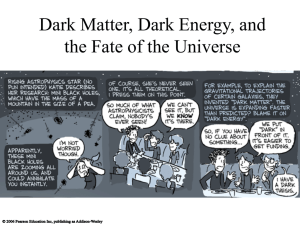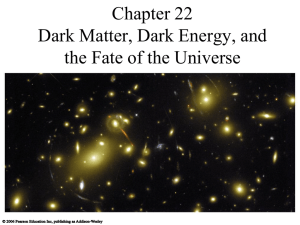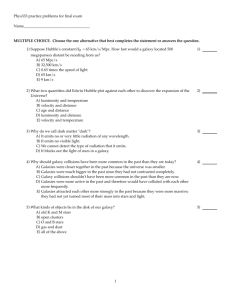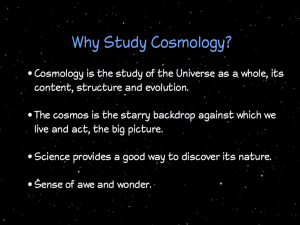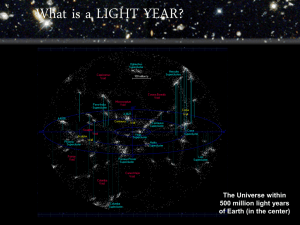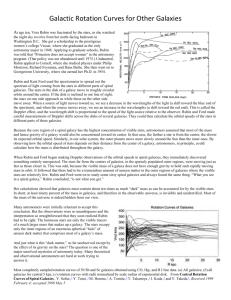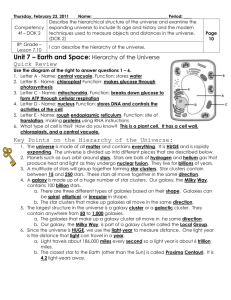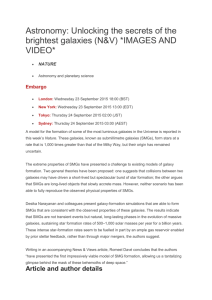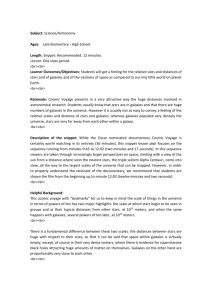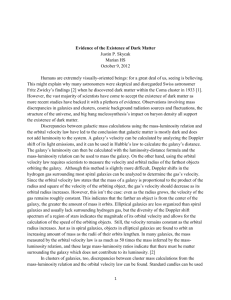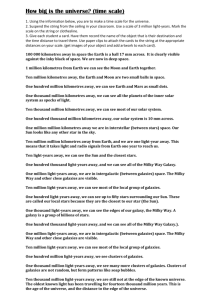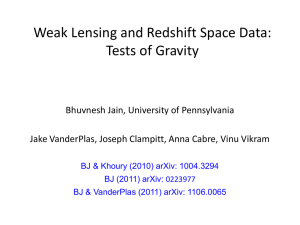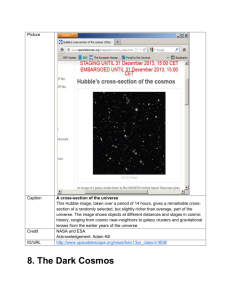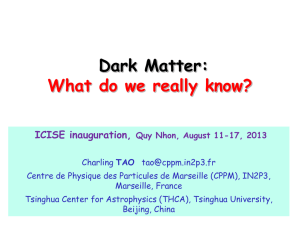Chapter 22
advertisement
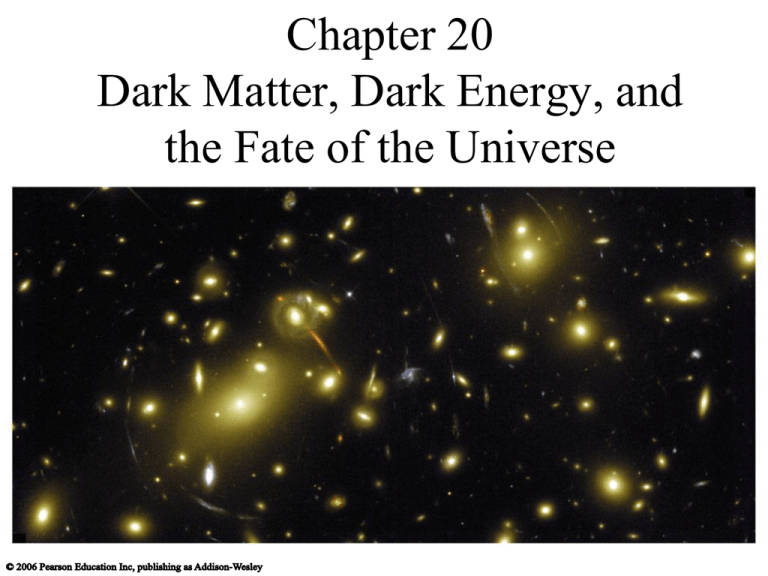
Chapter 20 Dark Matter, Dark Energy, and the Fate of the Universe Unseen Influences Dark Matter: An undetected form of mass that emits little or no light but whose existence we infer from its gravitational influence Dark Energy: An unknown form of energy that seems to be the source of a repulsive force causing the expansion of the universe to accelerate Contents of Universe • “Normal” Matter: ~ 4.4% – Normal Matter inside stars: – Normal Matter outside stars: • Dark Matter: • Dark Energy ~ 0.6% ~ 3.8% ~ 25% ~ 71% What is the evidence for dark matter in galaxies? Newton’s Description of Gravity Yields 𝐹 = 𝑚𝑎 𝐺𝑚1 𝑚2 𝑟2 = 𝑚1 𝑎 = 𝑣= 𝑣2 𝑚1 𝑟 𝐺𝑚 𝑟 Where m is the mass contained inside of the radius r Orbital velocity Orbital velocity curve if most of the mass was at the center of the galaxy. Radius 𝑣= 𝐺𝑚 𝑟 The Mass of the Milky Way If all mass was concentrated in the center, Rotation curve would follow a modified version of Kepler’s 3rd law. Rotation Curve = orbital velocity as function of radius. The Mass of the Milky Way (II) Total mass in the disk of the Milky Way: Approx. 200 billion solar masses Additional mass in an extended halo: Total: Approx. 1 trillion solar masses Most of the mass is not emitting any radiation: dark matter! Mass within Sun’s orbit: 1.0 x 1011 MSun Total mass: ~1012 MSun The visible portion of a galaxy lies deep in the heart of a large halo of dark matter We can measure rotation curves of other spiral galaxies using the Doppler shift of the 21-cm line of atomic H Astronomers calculate a mass to light ratio. Galaxy luminosity is measured to estimate the amount of mass in the stars. Total mass is found from motion. Orbital velocities of the gas clouds and stars. If total mass is larger than that attributed to stars difference must be due to dark matter. Spiral galaxies all tend to have flat rotation curves indicating large amounts of dark matter :10x as much dark matter as normal or 90% of mass is dark Slowest Fastest Remember the motion of stars in elliptical galaxies is more random than in spirals so you cannot get an orbital velocity curve. There is also very little H2 in elliptical galaxies. Broadening of spectral lines in elliptical galaxies tells us how fast the stars are orbiting. Different parts of the galaxy have similar spectral broadening. These galaxies also have dark matter What is the evidence for dark matter in clusters of galaxies? Fritz Zwicky did this in the 1930s • Treating galaxy clusters as orbiting the common center of mass • Measures speed of the whole cluster • Found individual speeds of the galaxies around the center of mass • Calculated the mass of clusters • He found dark matter to be ~50x that of normal matter Result was too radical for others to accept. Now with the spiral galaxy data and other independent methods confirming this result it has been accepted. Clusters contain large amounts of Xray emitting hot gas Temperature of hot gas (particle motions) tells us cluster mass: 85% dark matter 13% hot gas 2% stars Gravitational lensing, the bending of light rays by gravity, can also tell us a cluster’s mass All three methods of measuring cluster mass indicate similar amounts of dark matter Does dark matter really exist? Our Options 1. Dark matter really exists, and we are observing the effects of its gravitational attraction 2. Something is wrong with our understanding of gravity, causing us to mistakenly infer the existence of dark matter Because gravity is so well tested, most astronomers prefer option #1 What might dark matter be made of? A bit of terminology Baryons: protons and neutrons Normal matter is sometimes called baryonic matter Nonbaryonic matter is the other stuff. What ever it may be. Two Basic Options • Ordinary Dark Matter (MACHOS) – Massive Compact Halo Objects: dead or failed stars in halos of galaxies • Extraordinary Dark Matter (WIMPS) – Weakly Interacting Massive Particles: mysterious neutrino-like particles The Best Bet MACHOs occasionally make other stars appear brighter through lensing MACHOs occasionally make other stars appear brighter through lensing … but not enough lensing events to explain all the dark matter Why Believe in WIMPs? • There’s not enough ordinary matter • WIMPs could be left over from Big Bang • Models involving WIMPs explain how galaxy formation works What is the role of dark matter in galaxy formation? Gravity of dark matter is what caused protogalactic clouds to contract early in time WIMPs can’t contract to center because they don’t radiate away their orbital energy Dark matter is still pulling things together After correcting for Hubble’s Law, we can see that galaxies are flowing toward the densest regions of space What are the largest structures in the universe? Maps of galaxy positions reveal extremely large structures nearby: superclusters and voids; and a near uniform distribution on the larger scale. Time in billions of years 0.5 2.2 5.9 8.6 13.7 13 35 70 93 140 Size of expanding box in millions of lt-yrs Models show that gravity of dark matter pulls mass into denser regions – universe grows lumpier with time Structures in galaxy maps look very similar to the ones found in models in which dark matter is WIMPs Will the universe continue expanding forever? Two Options • The density of the universe is large enough that gravity will cause the universe to collapse back on itself. • The universe will expand forever. • Normal matter only contributes about 0.5% of the matter density needed to cause the universe to collapse Fate of universe depends on the amount of dark matter Lots of dark matter Critical density of matter Not enough dark matter Amount of dark matter is ~25% of the critical density suggesting fate is eternal expansion Not enough dark matter But expansion appears to be speeding up! Dark Energy? Not enough dark matter Brightness of distant white-dwarf supernovae tells us how much universe has expanded since they exploded An accelerating universe best fits the supernova data, and puts the age of the universe just under 14 billion years old.
